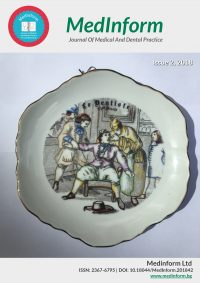Issue Two 2018
2018, Vol. 5 issue 2, (June)
Original Article
HCV AND DRUG ABUSERS – morphological changes (Liver biopsy in CHC and heroin abuse)
Abstract:
The aim of the study was to evaluate the morphological changes in the liver biopsies from patients with chronic hepatitis C (CHC) and heroin abuse (HA). Material and methods: In the study were included 10 patients with CHC and HA (9 m, 1 f, mean age 24,2±3,26 y) and 36 patients (25 m, 9 f) with no HA and CHC (n=22, mean age 32,68 ±11,41y) or chronic hepatitis B (CHB, n=14, mean age 24,00±3,66 y). The diagnosis of chronic hepatitis was put according to standard criteria and liver biopsy was done in all cases. The grading of activity and staging of fibrosis by METAVIR, the presence of steatosis and depletion of glycogen content was evaluated after using HE, V. Gieson, Gomori and PAS stains. Results: In the group of HA patients with CHC were found more often moderate grade of inflammation (A2, 60%) and clinically significant stage of fibrosis (F2, 70%) while in the both groups of non- HA patients with CHC or CHB the prevalences of mild grade of activity (A1, 59% and 50%, respectively) and early stage of fibrosis (F1, 59% and 71%) were predominant. No significant differences were found in the comparison of HA patients with CHC and non- HA control groups regarding the presence of steatosis and decrease of glycogen contents in hepatocytes. In conclusion, our study showed that in liver biopsies of patients with CHC and heroin abuse there were more severe morphological changes including grading and staging of chronic hepatitis compared to the cases with CHC or CHB without history of drug abuse.
Authors:
Desislava Lubomirova; Department of nephrology, hematology and gastroenterology, Medical University, Pleven; Clinic of gastroenterology, University Hospital ”Dr G. Stranski” Pleven;Ivanka Marinova; Department of nephrology, hematology and gastroenterology, Medical University, Pleven; Clinic of gastroenterology, University Hospital ”Dr G. Stranski” Pleven;
, Reni Ivanova2; Department of general and clinical pathology, Medical University, Pleven; University Hospital ”Dr G. Stranski” Pleven;
Ivan Ivanov2; Department of general and clinical pathology, Medical University, Pleven; University Hospital ”Dr G. Stranski” Pleven;
Angelika Velkova3; Department of Social medicine, Medical University-Sofia;
Kaloian Stoychev4; Department of psychiatry and medical psychology, Medical University, Pleven; Second Pcychiatric Clinic, University Hospital ”Dr G. Stranski” Pleven;
Ivan Lalev1; Department of nephrology, hematology and gastroenterology, Medical University, Pleven; Clinic of gastroenterology, University Hospital ”Dr G. Stranski” Pleven;
Radina Ivanova5; Laboratory of clinical pathology, University Hospital “St. I. Rilski”, Medical University, Sofia;
Pavlina Iordanova – Laleva6; Faculty of Pharmacy, Medical University, Pleven; Department of Clinical laboratory, University Hospital ”Dr Georgi Stranski” Pleven;
Zaharinka Sabeva1; Department of nephrology, hematology and gastroenterology, Medical University, Pleven; Clinic of gastroenterology, University Hospital ”Dr G. Stranski” Pleven;
Margarita Vlahova1; Department of nephrology, hematology and gastroenterology, Medical University, Pleven; Clinic of gastroenterology, University Hospital ”Dr G. Stranski” Pleven;

